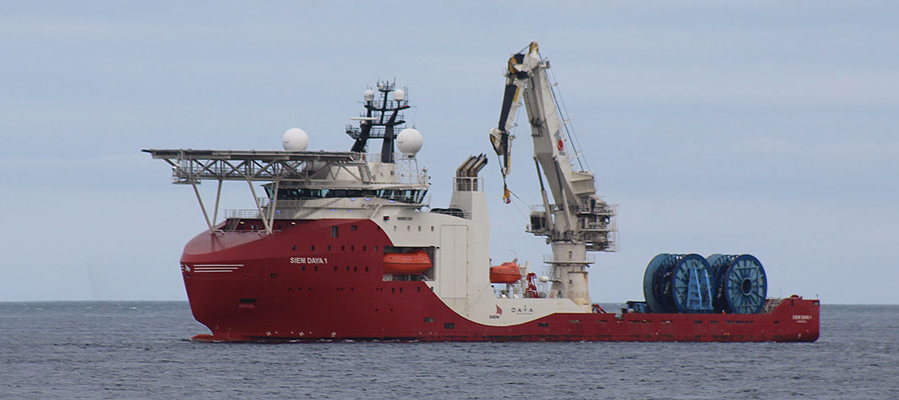Despite growing doubts about the future of tidal power in Wales, a 100MW scheme proposed for Northern Ireland is planning to submit a marine license application in the summer.
The $570m Fair Head Tidal Energy Park is being developed by a joint venture between Cork-based DP Energy and Belgium’s Bluepower. It would be installed in the north-east of the province, off the coast of north Antrim (map pictured), and is expected to generate enough electricity to provide for the needs of around 70,000 households.
Extensive onshore and offshore surveys have already been performed for the area, and are currently being analysed. The findings will be included in the marine license application.
Construction is on track to begin in 2018, Cleantechnica reports.
The problem with tidal power, simply put, is that at the moment we have not seen any ideas come forward that can hit a strike price in terms of pounds per megawatt-hour that is very attractive. That is the challenge for tidal– David Cameron, UK Prime Minister
Clodagh McGrath, DP Energy’s project manager, said: “The Fair Head Tidal development strategy is to progress with a 100MW offshore consent application and build the project in phases, planned to commence in 2018. In the past three years we have engaged with a wide range of project stakeholders including local communities and government departments.”
The first phase of the project would begin with a 10MW pilot array.
Meanwhile, a $1bn plan to install a pioneering lagoon-based system near Swansea in south Wales has been thrown into doubt by the UK government’s uncertainty about its policy towards tidal energy.
In particular, the government has been concerned about the “strike price” at which its power would be bought.
David Cameron, the prime minister of the UK, told a committee of MPs in January that his enthusiasm toward the scheme has been “reduced” by concerns over the strike price.
Cameron said: “The problem with tidal power, simply put, is that at the moment we have not seen any ideas come forward that can hit a strike price in terms of pounds per megawatt-hour that is very attractive. That is the challenge for tidal. Maybe they can come up with something.
“They are very long-term schemes with big investments up front, and they can last for many, many years, but right now my enthusiasm is reduced slightly by the fact that the cost would be quite high.”

Cable laying off the coast of Land’s End (MeyGen)
The project is now the subject of an independent review, which means that a decision is not expected until the autumn.
Mike Shorrock, the chief executive of Tidal Lagoon Power, told the Environment Analyst: “The project planned for Swansea Bay is ready to go now. We have built a team, secured planning permission, secured equity sponsors, prepared a delivery team and a supply chain.
“We have received overwhelming support for this project locally, nationally and internationally. If tidal lagoon power at scale is to be a real option for the longer term, we need to start work on Swansea Bay Tidal Lagoon now. Otherwise the opportunity will be lost and the review will be all for nothing.”
The China Harbour Engineering Company was chosen to build and part-finance the scheme in June last year.
The situation in England and Wales contrasts with Scotland, where the world’s biggest tidal scheme is nearing completion off the coast of John o’ Groats at Pentland Firth. The $1.5bn MeyGen project, which began construction in 2014, will use 269 underwater turbines to produce 400MW of electricity.
Atlantis Resources, the Singaporean-based company that is the majority owner of MeyGen, is presently engaged on underwater cabling and installing transformers. The scheme is expected to begin producing electricity this year.
According to the Quartz, Atlantis Resources will begin construction on another tidal-turbine project in the nearby Sound of Islay later this year.
A video demonstrating the engineering concept behind the turbines is available here.
Top image: The location of the Fair Head Tidal Scheme in Antrim (Fair Head Tidal)
Edited 4 March to correct the location of the MeyGen project.
Comments
Comments are closed.







To the PM. may be asked the prime question: Just how can anyone predict actual cost per megawatt hour when no one can interpolate such a cost seeing that tidal power generation has yet to become a reality? Then again how does one predict the useful life of such an exposed form of power generation? It makes great sense to start with the small scale pilot scheme to test the viability inherent in the use of tidal power generation! Possible different prototypes could be assessed to choose the best overall one to use on bigger and better schemes! Governments usually prefer the venture capitalists to get such ideas transformed into actual working viable and feasible examples before committing public capital to such schemes!
The pilot scheme was running in Strangford Lough for some years, I passed it in a boat. It had two big propellors. The tides where the new scheme is are very strong, so strong that the engine in a small yacht may not make progress against them, as we found out later. We should have waited a few hours and had a longer breakfast, until the tide turned. As it does, regularly, about four times a day. Returns on investment every day, at no radioactive risk to the public. All we need now is to wash out some of those deep salt caverns in Larne Lough to create some compressed air storage for in between times.